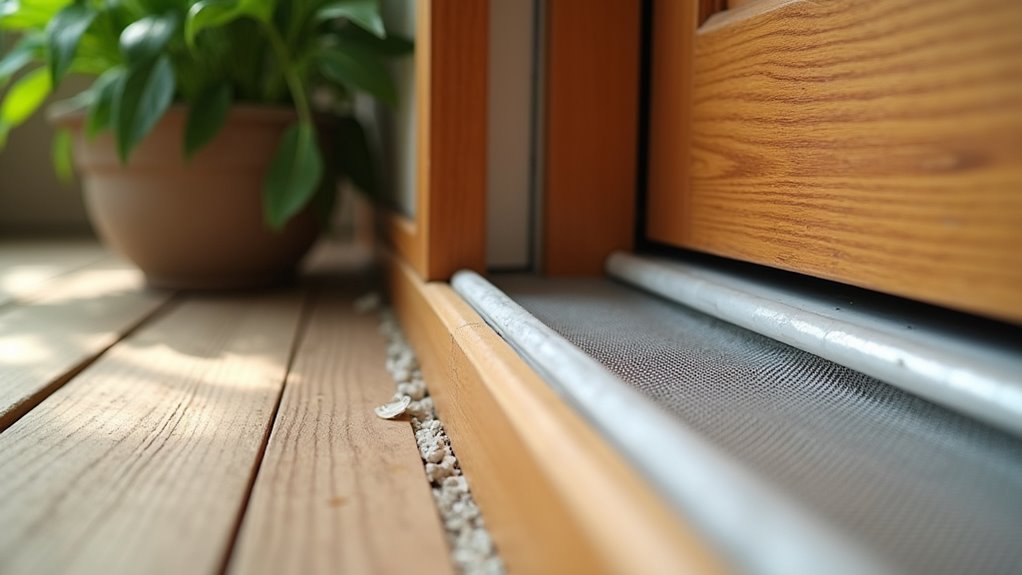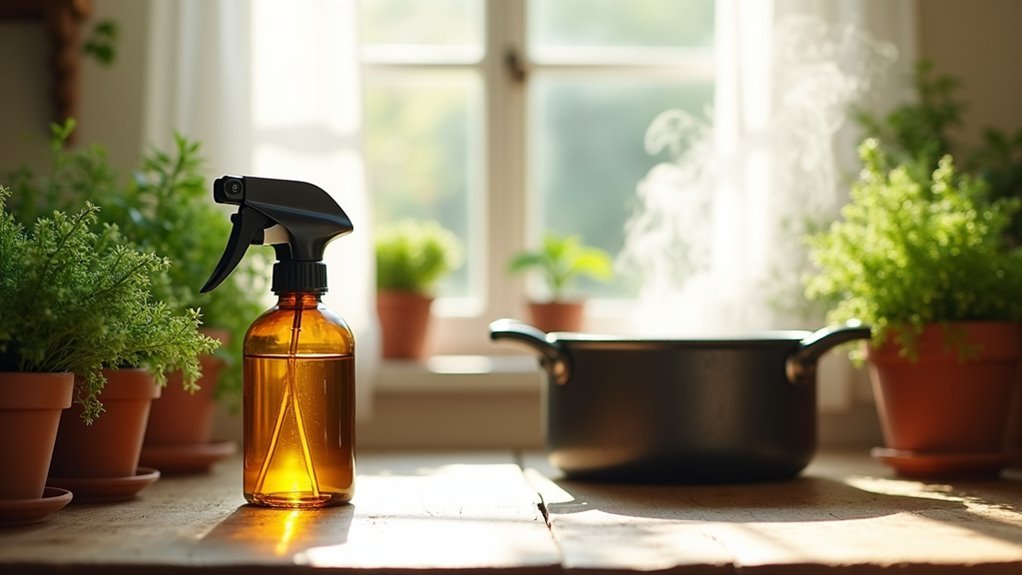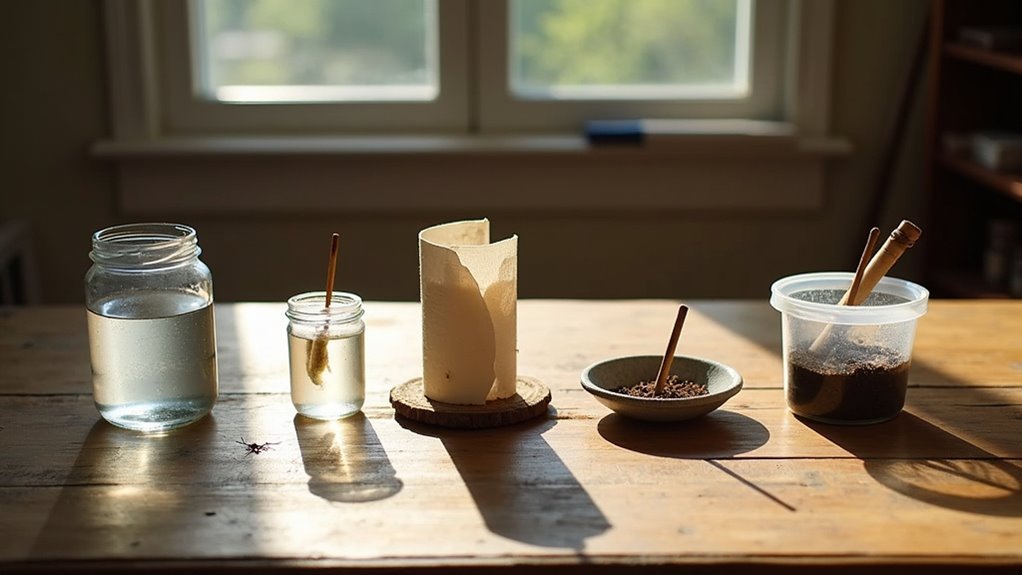You can create sustainable cockroach barriers by sealing cracks and openings with caulk since cockroaches squeeze through spaces as small as 1/8 inch. Control moisture by fixing leaks and emptying pet water dishes overnight. Use natural repellents like peppermint and tea tree oils to disrupt their sensitivity. Declutter storage areas and store food in airtight containers to eliminate hiding spots. Apply diatomaceous earth as a non-toxic deterrent that damages their exoskeletons. These thorough strategies will transform your home into an inhospitable environment for these persistent pests.
Physical Exclusion Through Sealing and Structural Modifications

Since cockroaches can squeeze through openings as small as 1/8 inch, you’ll need to take a systematic approach to sealing your home’s entry points.
Start by sealing cracks in walls, floors, and around pipes using caulk for smaller gaps and steel wool for larger ones. Install door sweeps and weather stripping on all exterior doors and windows to create effective barriers.
Seal cracks with caulk, fill larger gaps with steel wool, and install door sweeps to block cockroach entry points.
Don’t forget about inspecting screens regularly and repairing any damage that could allow access. For long-term prevention, consider structural modifications like raising wooden structures off the ground.
This discourages cockroach habitation since they prefer dark, moist environments close to earth. These sustainable barriers create multiple layers of protection against unwanted invaders.
Moisture Control and Water Source Elimination
Water acts as a survival lifeline for cockroaches, so eliminating moisture sources becomes your most powerful weapon in the battle against these persistent pests.
Effective moisture control requires fixing leaky faucets and pipes immediately to remove standing water sources. You’ll need to inspect and clean areas around sinks and dishwashers regularly, keeping surfaces clean and dry after each use.
Water source elimination extends beyond obvious leaks. Empty pet water dishes overnight and maintain low humidity levels using dehumidifiers when necessary.
These pest control methods greatly reduce cockroach infestations while minimizing health risks. Proper sanitation through immediate spill cleanup and regular cleaning of kitchen surfaces prevents moisture buildup.
Consistent practices that discourage cockroaches create sustainable barriers more effectively than chemical treatments alone.
Natural Repellents and Essential Oil Barriers

Beyond controlling moisture, you can create powerful natural barriers using essential oils and plant-based repellents that cockroaches actively avoid.
Peppermint oil, tea tree oil, and eucalyptus emit strong scents that disrupt cockroaches’ environmental sensitivity, making your space inhospitable. These essential oils provide eco-friendly cockroach control while maintaining food safety standards.
Diatomaceous earth creates an effective physical barrier that damages cockroaches’ exoskeletons, causing dehydration and death without harming humans or pets.
You’ll achieve sustainable pest control by combining baking soda with sugar – cockroaches ingest this mixture, producing lethal gas internally.
For long-lasting results, incorporate cockroach-repelling plants like peppermint and rosemary around your home.
These natural repellents minimize chemical pesticide dependence while creating multiple defense layers that repel cockroaches effectively.
Habitat Disruption Through Decluttering and Sanitation
While essential oils create chemical barriers, eliminating cockroaches’ preferred habitats through strategic decluttering delivers equally powerful results. You’ll disrupt their survival by removing hiding spots and food sources that sustain pest populations.
| Problem Areas | Solutions |
|---|---|
| Cluttered storage spaces | Regular decluttering and organization |
| Food debris and spills | Immediate sanitation practices |
| Open food containers | Airtight containers for all supplies |
Effective habitat disruption requires consistent sanitation habits. You should clean spills promptly, store food properly, and inspect storage areas regularly for cockroach activity. This systematic approach creates a clean environment that’s inhospitable to pests.
Biological Controls and Eco-Friendly Deterrents

Nature provides powerful allies in your fight against cockroaches through biological controls that work with existing ecosystems rather than against them. You can introduce natural predators like wasps and beetles to effectively reduce cockroach populations while promoting biodiversity.
Beneficial nematodes offer another sustainable approach, releasing bacteria that eliminate pests while remaining safe for your family and pets.
For eco-friendly deterrents, you’ll find essential oils like peppermint and tea tree effectively repel cockroaches while creating pleasant aromas.
Diatomaceous earth serves as an excellent natural pesticide, damaging cockroach exoskeletons and causing dehydration without toxic effects.
These non-toxic sustainable barriers form extensive pest management strategies that protect your home while preserving environmental health.
Frequently Asked Questions
How to Get Rid of Cockroaches Environmentally Friendly?
You can eliminate cockroaches naturally by using peppermint oil, sprinkling diatomaceous earth, creating boric acid baits, sealing food containers, removing crumbs, and blocking entry points while reducing moisture sources.
How Do You Make a Roaches Barrier?
You’ll create a roach barrier by sealing cracks with caulk, applying diatomaceous earth around entry points, installing door sweeps, maintaining cleanliness, and planting repelling herbs like mint near your home’s perimeter.
What Material Can Cockroaches Not Climb?
You’ll find cockroaches can’t climb smooth glass, polished metals, or slick plastics. They also struggle with silicone and rubber surfaces since these materials don’t provide the grip they need.
What Do Roaches Hate Most?
You’ll find roaches hate strong scents like peppermint, eucalyptus, and tea tree oils most. They’re also repelled by diatomaceous earth, boric acid, dry conditions, and clean, organized spaces without clutter.
In Summary
You’ve now got five powerful, sustainable strategies to keep cockroaches out of your home without relying on harsh chemicals. By sealing entry points, controlling moisture, using natural repellents, maintaining cleanliness, and employing biological controls, you’ll create an environment that’s unwelcoming to these pests. Remember, consistency is key—combine these methods and stick with them for long-term success. Your home will be cockroach-free while protecting your family and the environment.





Leave a Reply